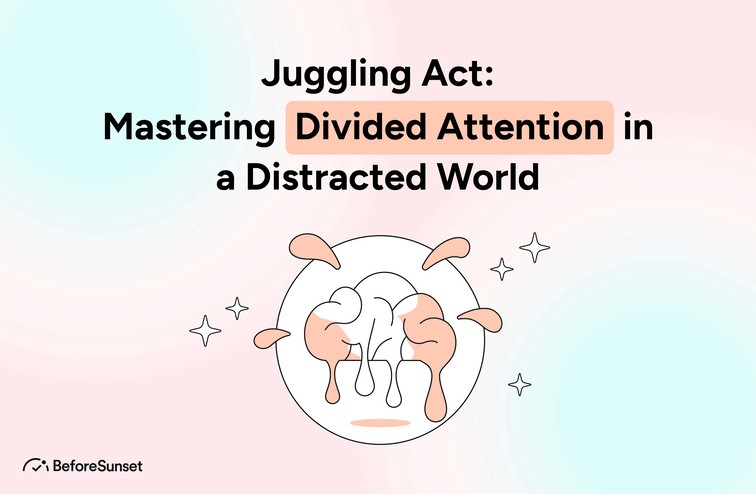In the fast-paced and interconnected world we live in, mastering the art of divided attention has become a crucial skill for navigating the demands of daily life. The constant influx of information, coupled with the myriad of tasks vying for our attention, has turned our daily routine into a juggling act.
Welcome to "Juggling Act: Mastering Divided Attention in a Distracted World," where we explore the challenges of balancing multiple tasks, responsibilities, and priorities in an environment that seems designed to pull us in countless directions simultaneously.

History and Background on Divided Attention
With early influences originating in the late 19th century, the study of split attention has a long history in psychology. The influential book "The Principles of Psychology" by American psychologist William James, a trailblazer, contributed significantly to our understanding of attention (1890).
James presented the idea that people have a limited capacity for conscious awareness in this seminal essay. He also explored the concept of attention, suggesting that attention is a finite resource that may be split among various activities or stimuli.
The dual-task paradigm's debut in the middle of the 20th century gave the formal study of split attention a boost. This type of experimentation, which looks at a person's capacity to multitask, has proven essential to understanding the workings and constraints of split attention.
Prominent psychologists like Donald Broadbent helped shape theories on attention and information processing, which set the stage for more studies in this field.
Researchers started using increasingly complex approaches to examine split attention as technology developed. Scientists have acquired insights into the brain underpinnings of split attention with the development of neuroimaging methods such as electroencephalography (EEG) and functional magnetic resonance imaging (fMRI).
These methods made it possible to comprehend how the brain distributes resources when it is faced with several cognitive demands on it.
The use of split attention has drawn special interest from the fields of cognitive psychology and human factors research. Research on how multitasking affects everyday activities like driving, working, and communicating has shed important light on the difficulties and dangers of attempting to split attention across several things.
The Role of Attention in Cognitive Processes
Attention, a fundamental aspect of cognitive functioning, plays a pivotal role in shaping how we perceive, process, and interact with the world around us. The study of attention within cognitive processes is a multifaceted exploration of the mechanisms that govern the selective allocation of mental resources.
From the early formulations by psychologists such as William James to contemporary neuroscientific investigations, attention has emerged as a key determinant in various cognitive functions

What is Attention?
The cognitive process of attention entails the deliberate concentration and distribution of mental energy towards particular stimuli or tasks. Through the ability to filter and prioritize information from the wide range of sensory input in their environment, people may engage with their surroundings more effectively and meaningfully.
The two main characteristics of attention are its dynamic nature, which allows it to be sustained over time or changed to new stimuli as needed, and its restricted capacity, which limits how much information an individual can focus on at once.
This cognitive process affects memory, perception, judgment, and other higher-order cognitive processes. It is a key factor in determining how people interact with and react to their environment. With roots in cognitive science, psychology, and neuroscience, the multidisciplinary study of attention sheds light on the intricate workings of human cognition.
How Does Attention Influence Cognitive Processes?
By regulating and altering a variety of cognitive processes necessary for our engagement with the outside world, attention acts as a cognitive gateway. One of attention's main functions is as a filter in perception, enabling us to focus on particular stimuli and weed out unimportant information.
Our perceptions are shaped by this selective attention, which helps us create a meaningful and cogent picture of our environment. For example, during a discussion, paying attention enables us to focus on the speaker's words above other distractions, resulting in more efficient communication.
When it comes to memory, attention is essential to the encoding and retrieval of information. Attention aids in retrieving pertinent details during the recall of information, and material that grabs our attention is more likely to be stored in memory.
Given that focused attention improves the encoding of new information and aids in the acquisition of knowledge and skills, the relationship between attention and memory highlights the significance of attention in learning.
Since attention focuses cognitive resources on pertinent information, it is essential for problem-solving and decision-making. When weighing alternatives or examining data, attention enables people to focus on important details, which promotes more efficient problem-solving techniques.
On the other hand, task performance as a whole may be impacted by the capacity to split attention between activities. While multitasking could be required in some circumstances, it frequently results in decreased efficacy and efficiency since cognitive resources are being distributed unevenly.
Attention has a major role in cognitive regulation, which includes functions like working memory, inhibition, and flexibility. Paying attention enables people to stay focused on their objectives, block out distractions, and switch their attention between tasks as needed. Achieving goals and completing tasks successfully are facilitated by effective cognitive control.
Attention is also essential in the realm of language processing. The selection of pertinent linguistic information is guided by attention while reading or listening to spoken language. Through focused attention to certain words or phrases, people are better able to understand and interpret language.
Another aspect of cognitive processing that is impacted by attention is emotion management. The intensity and length of emotional experiences are influenced by the direction attention is directed—that is, toward or away from emotionally charged stimuli. People are able to control their emotions by deciding where to focus their attention in a certain circumstance.
What Role Does Divided Attention Play in Cognitive Processes?
Because it enables people to devote mental resources to several activities or stimuli at once, divided attention, also known as multitasking, is important for cognitive functions. This skill is essential in the fast-paced, complicated world of today when people frequently have to choose between conflicting demands on their time.
Cognitive functions like information processing, problem-solving, and decision-making are impacted by divided attention. Although it makes it possible for people to manage several things at once, it has a drawback in that the cognitive resources allotted to each activity may be reduced, which might result in worse performance on one or more tasks.
The study of split attention offers a sophisticated knowledge of how cognitive processes adapt and interact when attention is divided across different activities, which sheds light on the drawbacks and difficulties of multitasking.
This study adds to the body of knowledge about practical issues in domains such as workplace efficiency, safety, and human-computer interface, where maximizing split attention is essential to efficient task completion.

Impact of Divided Attention on Performance
Divided attention, also known as multitasking, occurs when an individual attempts to focus on and manage multiple tasks simultaneously. This can have various impacts on cognitive and task performance, and the effects may vary depending on the nature of the tasks involved. Here are some general insights into the impact of divided attention on performance:
1. Reduced Performance on Primary Tasks:
Divided attention often leads to a decline in performance on the primary task. When cognitive resources are split among multiple activities, individuals may struggle to maintain the same level of focus and quality of work on each task.
2. Slower Processing and Increased Errors:
Multitasking can result in slower processing of information and an increased likelihood of errors. The brain must constantly switch between tasks, leading to delays in decision-making and problem-solving.
3. Impaired Memory Encoding and Retrieval:
Divided attention can negatively impact memory processes. When attention is divided, there may be difficulties in encoding new information into memory and retrieving stored information when needed.
4. Decreased Task Satisfaction:
Multitasking often leads to a lower level of satisfaction with completed tasks. Individuals may feel overwhelmed, stressed, or dissatisfied due to the increased mental effort required to manage multiple tasks simultaneously.
5. Impact on Learning:
Divided attention can hinder the learning process. Research suggests that individuals who multitask during learning activities may have a reduced ability to acquire and retain information compared to those who focus on one task at a time.
6. Increased Stress and Fatigue:
Juggling multiple tasks can contribute to higher stress levels and increased mental fatigue. The constant switching of attention can lead to a feeling of mental exhaustion, affecting overall well-being.
7. Impaired Communication:
Multitasking can affect communication, especially in situations that require active listening and effective verbal or non-verbal communication. Divided attention may result in misunderstandings and missed cues.
8. Risk of Accidents:
In certain contexts, such as driving or operating machinery, divided attention can significantly increase the risk of accidents. Tasks that demand full concentration, like driving, can become dangerous when attention is divided.

Strategies for Improving Performance with Divided Attention Tasks
Improving performance in tasks that require divided attention involves developing strategies to manage multiple activities more effectively. While complete elimination of divided attention is often ideal for certain tasks, there are situations where multitasking is unavoidable. Here are some strategies to enhance performance in divided attention tasks:
1. Prioritize Tasks:
Identify the most critical tasks and prioritize them. Focus on completing one high-priority task before moving on to others. This helps ensure that the most important work receives adequate attention and is less likely to be compromised.
2. Chunking:
Break down complex tasks into smaller, manageable chunks. By dividing tasks into more digestible components, you can allocate attention more effectively and reduce the cognitive load associated with each subtask.
3. Time Blocking:
Allocate specific time blocks for different tasks. This can help create a structured schedule and prevent constant task-switching. During each time block, concentrate solely on the designated task.
4. Set Realistic Expectations:
Be realistic about what you can accomplish simultaneously. Avoid overloading yourself with too many tasks, as this can lead to decreased performance across the board.
5. Practice Mindfulness:
Cultivate mindfulness to enhance your ability to focus on the present moment. Mindfulness techniques, such as deep breathing or meditation, can help improve concentration and reduce the impact of distractions.
6. Use Technology Wisely:
Leverage technology to streamline tasks and automate processes when possible. Tools like productivity apps and reminders can help you stay organized and on track.
7. Create a Distraction-Free Environment:
Minimize external distractions by creating a dedicated and organized workspace. Turn off non-essential notifications and communicate with others when you need focused time.
8. Batch Similar Tasks:
Group similar tasks together to minimize the need for constant mental context switching. This allows you to use similar cognitive processes for related activities, improving efficiency.
9. Take Breaks:
Schedule short breaks between tasks to refresh your mind. Regular breaks can help prevent mental fatigue and maintain overall cognitive performance.
10. Improve Time Management:
Enhance your time management skills by setting clear goals, creating to-do lists, and estimating the time required for each task. This helps you allocate time more efficiently.
11. Develop Dual-Task Skills:
With practice, some individuals can improve their ability to handle divided attention tasks. Engage in activities that involve dual-tasking to enhance your multitasking skills gradually.
12. Continuous Learning:
Stay open to new techniques and technologies that can improve your ability to manage divided attention. Continuous learning can provide you with tools and strategies to adapt to changing demands.
Give Your Full Attention To Your Work
Organize tasks, set priorities, and create to-do lists. BeforeSunset AI can help you visualize your workload, break it down into manageable tasks, and track progress. It helps you give your full attention to your work. Try it out today.


